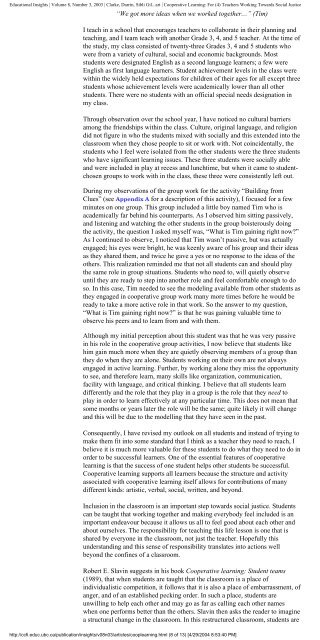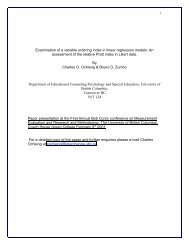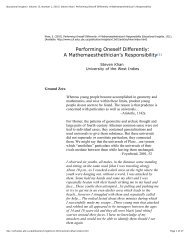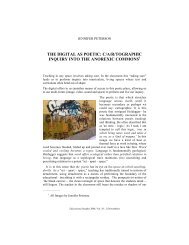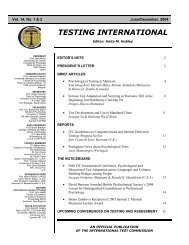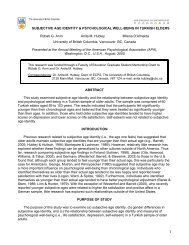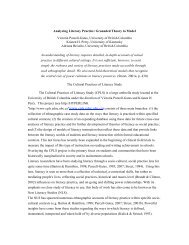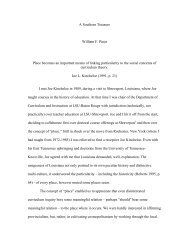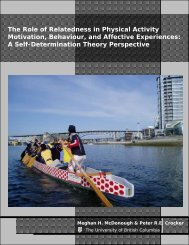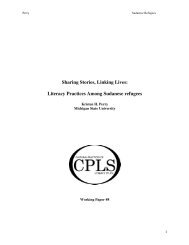Educational Insights | Volume 8, Number 3, 2003 | Clarke, Darrin ...
Educational Insights | Volume 8, Number 3, 2003 | Clarke, Darrin ...
Educational Insights | Volume 8, Number 3, 2003 | Clarke, Darrin ...
You also want an ePaper? Increase the reach of your titles
YUMPU automatically turns print PDFs into web optimized ePapers that Google loves.
<strong>Educational</strong> <strong>Insights</strong> | <strong>Volume</strong> 8, <strong>Number</strong> 3, <strong>2003</strong> | <strong>Clarke</strong>, <strong>Darrin</strong>, Sibli Gil...art | Cooperative Learning: For (4) Teachers Working Towards Social Justice<br />
“We got more ideas when we worked together…” (Tim)<br />
I teach in a school that encourages teachers to collaborate in their planning and<br />
teaching, and I team teach with another Grade 3, 4, and 5 teacher. At the time of<br />
the study, my class consisted of twenty-three Grades 3, 4 and 5 students who<br />
were from a variety of cultural, social and economic backgrounds. Most<br />
students were designated English as a second language learners; a few were<br />
English as first language learners. Student achievement levels in the class were<br />
within the widely held expectations for children of their ages for all except three<br />
students whose achievement levels were academically lower than all other<br />
students. There were no students with an official special needs designation in<br />
my class.<br />
Through observation over the school year, I have noticed no cultural barriers<br />
among the friendships within the class. Culture, original language, and religion<br />
did not figure in who the students mixed with socially and this extended into the<br />
classroom when they chose people to sit or work with. Not coincidentally, the<br />
students who I feel were isolated from the other students were the three students<br />
who have significant learning issues. These three students were socially able<br />
and were included in play at recess and lunchtime, but when it came to studentchosen<br />
groups to work with in the class, these three were consistently left out.<br />
During my observations of the group work for the activity “Building from<br />
Clues” (see Appendix A for a description of this activity), I focused for a few<br />
minutes on one group. This group included a little boy named Tim who is<br />
academically far behind his counterparts. As I observed him sitting passively,<br />
and listening and watching the other students in the group boisterously doing<br />
the activity, the question I asked myself was, “What is Tim gaining right now?”<br />
As I continued to observe, I noticed that Tim wasn’t passive, but was actually<br />
engaged; his eyes were bright, he was keenly aware of his group and their ideas<br />
as they shared them, and twice he gave a yes or no response to the ideas of the<br />
others. This realization reminded me that not all students can and should play<br />
the same role in group situations. Students who need to, will quietly observe<br />
until they are ready to step into another role and feel comfortable enough to do<br />
so. In this case, Tim needed to see the modeling available from other students as<br />
they engaged in cooperative group work many more times before he would be<br />
ready to take a more active role in that work. So the answer to my question,<br />
“What is Tim gaining right now?” is that he was gaining valuable time to<br />
observe his peers and to learn from and with them.<br />
Although my initial perception about this student was that he was very passive<br />
in his role in the cooperative group activities, I now believe that students like<br />
him gain much more when they are quietly observing members of a group than<br />
they do when they are alone. Students working on their own are not always<br />
engaged in active learning. Further, by working alone they miss the opportunity<br />
to see, and therefore learn, many skills like organization, communication,<br />
facility with language, and critical thinking. I believe that all students learn<br />
differently and the role that they play in a group is the role that they need to<br />
play in order to learn effectively at any particular time. This does not mean that<br />
some months or years later the role will be the same; quite likely it will change<br />
and this will be due to the modelling that they have seen in the past.<br />
Consequently, I have revised my outlook on all students and instead of trying to<br />
make them fit into some standard that I think as a teacher they need to reach, I<br />
believe it is much more valuable for these students to do what they need to do in<br />
order to be successful learners. One of the essential features of cooperative<br />
learning is that the success of one student helps other students be successful.<br />
Cooperative learning supports all learners because the structure and activity<br />
associated with cooperative learning itself allows for contributions of many<br />
different kinds: artistic, verbal, social, written, and beyond.<br />
Inclusion in the classroom is an important step towards social justice. Students<br />
can be taught that working together and making everybody feel included is an<br />
important endeavour because it allows us all to feel good about each other and<br />
about ourselves. The responsibility for teaching this life lesson is one that is<br />
shared by everyone in the classroom, not just the teacher. Hopefully this<br />
understanding and this sense of responsibility translates into actions well<br />
beyond the confines of a classroom.<br />
Robert E. Slavin suggests in his book Cooperative learning: Student teams<br />
(1989), that when students are taught that the classroom is a place of<br />
individualistic competition, it follows that it is also a place of embarrassment, of<br />
anger, and of an established pecking order. In such a place, students are<br />
unwilling to help each other and may go as far as calling each other names<br />
when one performs better than the others. Slavin then asks the reader to imagine<br />
a structural change in the classroom. In this restructured classroom, students are<br />
http://ccfi.educ.ubc.ca/publication/insights/v08n03/articles/cooplearning.html (8 of 13) [4/29/2004 8:53:40 PM]


